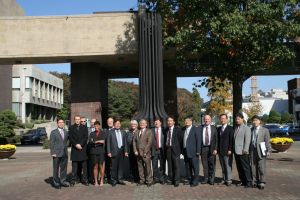Joint research of KIT and the Korean Institute of Science and Technology (KIST) focuses on the area of biological interfaces. Exchange of scientific know-how has taken place for more than 10 years. Now, the partners wish to extend it among others by establishing tandems of scientists, who jointly work on projects. Cooperation in other research areas is to follow rapidly. Representatives of both sides will prepare these cooperation projects at a meeting in Seoul this week.
“KIST was the first Korean institute to focus on the development and implementation of high technologies. In biology, it is in the top group worldwide. This makes it an interesting partner in Asia,” says Professor Volker Saile, Chief Science Officer at KIT and head of the delegation that visits KIST and other research centers and universities in Korea this week. “KIST was founded in the 1960s to further Korea – and it has succeeded.”
Cooperation in the field of biology is well-established: A memorandum of understanding was signed by Forschungszentrum Karlsruhe and KIST in 2003. KIT also maintains close relations to KIST Europe in Saarbrucken. “Our overlap in the area of biological interfaces is very large,” says Saile. Now, a cooperation contract is to be concluded for an even closer strategic cooperation. In summer, 20 scientists of KIT and KIST organized into groups of two persons each. These groups will jointly work on projects in the future. “For young researchers, it will be attractive to go to Seoul. There, the conditions are ideal, laboratories are well equipped,” emphasizes Professor Saile. In the long term, KIT and KIST plan to extend the cooperation to other areas, including robotics, water management, and materials sciences.
The history of KIST also is of interest to KIT. In the 1980s, KIST was a research institute and university at the same time. Meanwhile, both parts have become independent again. In Saile’s opinion, the merger failed, because it had been “enforced” by the state, whereas the KIT merger was based on the joint conviction of both partners.
The Daegu Gyeongbuk Institute of Science and Technology (DGIST) might soon become another Korean partner of KIT: It was founded as a research center in 2004 and is now establishing master and PhD programs as a university. It is planned to sign a memorandum of understanding in order to transfer the experience gained by KIT to Gyeongbuk.
Being “The Research University in the Helmholtz Association”, KIT creates and imparts knowledge for the society and the environment. It is the objective to make significant contributions to the global challenges in the fields of energy, mobility, and information. For this, about 10,000 employees cooperate in a broad range of disciplines in natural sciences, engineering sciences, economics, and the humanities and social sciences. KIT prepares its 22,800 students for responsible tasks in society, industry, and science by offering research-based study programs. Innovation efforts at KIT build a bridge between important scientific findings and their application for the benefit of society, economic prosperity, and the preservation of our natural basis of life. KIT is one of the German universities of excellence.

